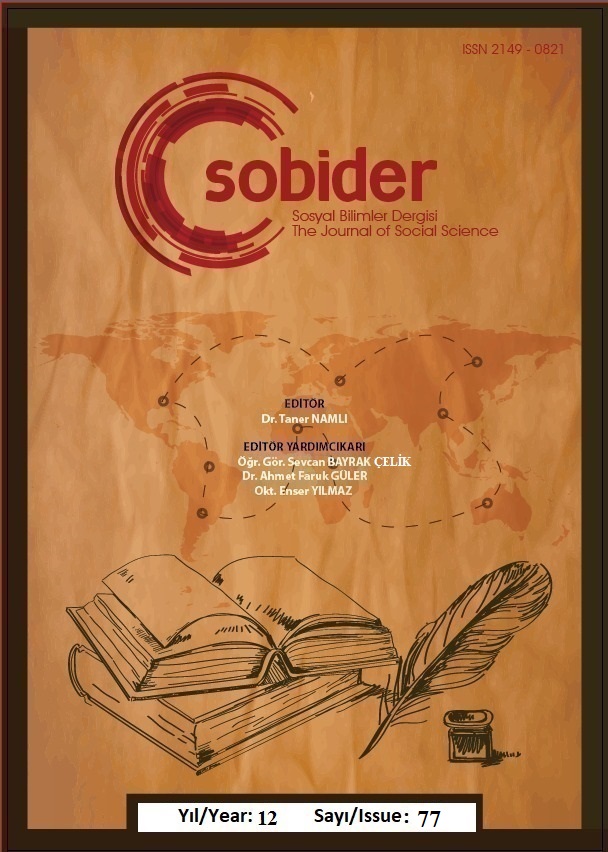ORTAOKUL 6.SINIF ÖĞRENCİLERİNDE CÜMLE PİRAMİDİ TEKNİĞİNİN KULLANIMININ ÖĞRENCİLERİN DİL BİLGİSİNE YÖNELİK TUTUMLARINA VE DİL BİLGİSİ BAŞARILARINA ETKİSİ
Author :
Abstract
Dilin doğru ve etkili biçimde yazılı yahut sözlü olarak kullanılabilmesi için dil bilgisi öğretimine gereksinim duyulmaktadır. Ancak dil bilgisi öğretimi, dil becerilerini geliştirmede bir araç olmalı, asla amaç haline getirilmemelidir. Dilin kurallarına uygun bir şekilde konuşulup yazılması dil bilgisi öğretimine bağlıdır. Bu sebeple, dil bilgisi kuralları eğitim kurumlarında öğrencilere ezberletilerek değil, dilin işlevleri kavratılarak, dil ile ilgili kural ve bilgiler metinler aracılığıyla sezdirilerek öğrencilere verilmelidir. Öğrenciler, metinlerden hareketle dilin işlevlerini sezmeli, metinde yer alan örnek yapılardan yola çıkarak dilin kurallarına ve dilin bilgisine kendileri ulaşmalıdır. Öğrenciler yazılı ve sözlü metinler aracılığıyla öğrenme süreci içerisinde doğrudan yer alabilmekte, örneklerden hareketle genel kurallara ulaşabilmekte, dilin işlevlerini metinler üzerinden somut olarak sezebilmektedirler. Dil yeteneğimizle evreni okuyabilir, kendimizi anlayabilir ve doğanın önemli bir parçası olduğumuzun farkına varabiliriz. Cümle piramidi, çizilen piramidin en dar kısmı olan en üstteki bölüme bir fiil veya isim soylu bir yüklem ile birlikte oluşacak her cümlenin sığabileceği sekiz satıra bölünmüş bir yapıdan meydana gelir. Piramidin her satır bölmesi için yan yüzünde soru ifadeleri yazılır. Piramidin en geniş kısmı tüm dil bilgisel yapı ve ögelerin bir arada olduğu en uzun cümle olma özelliğine sahip olan hedef cümledir. Hedef cümle, piramidin üst katlarında yer alan cümlelerin dil bilgisi ve anlamsal olarak en nihai sonucunu temsil eder. Cümle piramidi tekniğinin başarısı hedef cümlenin niteliği ve doğruluğuna bağlıdır. Bu çalışmada, cümle piramidi yönteminin altıncı sınıf öğrencilerinin yazma becerilerini geliştirme ve dil bilgisine karşı tutumlarına etkisi araştırılmıştır.
Keywords
Abstract
Grammar instruction is necessary for using language effectively, both orally and in writing. However, grammar instruction should be a tool for developing language skills, never the end goal. Speaking and writing according to the rules of a language depends on grammar instruction. Therefore, students should not be taught grammar rules in educational institutions by memorizing them, but by understanding the functions of the language itself, and by imparting language-related rules and information through texts. Students should understand the functions of language through texts and, based on the exemplary structures found in the text, access language rules and language knowledge on their own. Through written and spoken texts, students can directly participate in the learning process, access general rules through examples, and concretely perceive the functions of language through texts. With our linguistic abilities, we can read the universe, understand ourselves, and realize our essential nature. A sentence pyramid consists of a structure divided into eight lines, allowing each sentence, along with a verb or a noun, to fit into the narrowest section of the pyramid, the topmost section. The sentence pyramid consists of a structure divided into eight lines, the narrowest part of the pyramid being the top, where any sentence with a verb or a noun-based predicate can fit. Question statements are written on the side of the pyramid for each line segment. The widest part of the pyramid is the target sentence, which is the longest sentence containing all grammatical structures and elements. The target sentence represents the final grammatical and semantic result of the sentences on the upper levels of the pyramid. The success of the sentence pyramid technique depends on the quality and accuracy of the target sentence. This study investigated the effect of the sentence pyramid method on the development of sixth-grade students' writing skills and their attitudes toward grammar.





